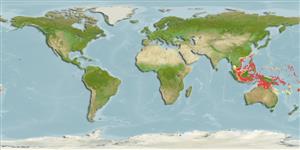Klassifizierung / Names
Namen | Synonyme | Catalog of Fishes(Gattung, Arten) | ITIS | CoL | WoRMS | Cloffa
>
Gobiiformes (Gobies) >
Gobiidae (Gobies) > Gobiinae
Etymology: Trimma: Greek, trimma, -atos = something crushed (Ref. 45335); xanthochrum: Name from the Greek ‘xanthos' meaning yellow or golden, and ‘chros’ for colour of the skin, or body surface, referring to the yellow colouration of the body and caudal fin..
More on author: Winterbottom.
Environment: milieu / climate zone / depth range / distribution range
Ökologie
seewasser demersal; tiefenbereich 12 - 70 m (Ref. 87358). Tropical
Western Pacific Ocean: Indonesia.
Size / Gewicht / Alter
Maturity: Lm ? range ? - ? cm
Max length : 2.5 cm SL Männchen/unbestimmt; (Ref. 87358)
Kurzbeschreibung
Morphologie | Morphometrie
Rückenflossenstacheln (insgesamt): 7; Rückenflossenweichstrahlen (insgesamt): 7-8; Afterflossenstacheln 1; Afterflossenweichstrahlen: 8. This species is characterized by the following: a wide interorbital region (80-100% pupil diameter); the second dorsal spine usually reaching posteriorly to between the bases of the second to third dorsal fin rays; pectoral rays 15-16, usually with 7-8 branched rays; vertical rows of sensory papillae below eye of 2-3 papillae in rows 1-4 and 4-5 in row 5; caudal blotch which has a lower half about two-thirds the width of the upper half; usually an overall yellowish body with yellow at least proximally in the caudal fin (Ref. 87358).
Inhabits current-prone reefs in 12-70 m (Ref. 90102).
Life cycle and mating behavior
Geschlechtsreife | Fortpflanzung | Ablaichen | Eier | Fecundity | Larven
Winterbottom, R., 2011. Six new species of the genus Trimma (Percomorpha; Gobiidae) from the Raja Ampat Islands, Indonesia, with notes on cephalic sensory papillae nomenclature. aqua, Int. J. Ichthyol. 17(3):127-162. (Ref. 87358)
IUCN Rote Liste Status (Ref. 130435)
Bedrohung für Menschen
Harmless
Nutzung durch Menschen
Mehr Information
NamenSynonymeMetabolismusRäuberÖkotoxikologieFortpflanzungGeschlechtsreifeAblaichenSpawning aggregationFecundityEierEientwicklung
Alter/GrößeWachstumLänge-GewichtLänge-LängeLängenhäufigkeitenMorphometrieMorphologieLarvenLarven Pop.Dyn.RekrutierungDichteBRUVS
ReferenzenAquakulturAquakultur ProfilZuchtlinienGenetikElectrophoresesVererbbarkeitKrankheitenVerarbeitungNutrientsMass conversion
PartnerBilderStamps, Coins Misc.LauteCiguateraGeschwindigkeitSchwimmstilKiemenoberflächeOtolithsGehirngrößeSehfähigkeit
Tools
Zusatzinformationen
Download XML
Internet Quellen
Estimates based on models
Preferred temperature (Ref.
123201): 26.7 - 28.9, mean 27.9 °C (based on 194 cells).
Phylogenetic diversity index (Ref.
82804): PD
50 = 0.5000 [Uniqueness, from 0.5 = low to 2.0 = high].
Bayesian length-weight: a=0.01023 (0.00477 - 0.02194), b=3.02 (2.84 - 3.20), in cm total length, based on LWR estimates for this (Sub)family-body shape (Ref.
93245).
Fishing Vulnerability (Ref.
59153): Low vulnerability (10 of 100).
